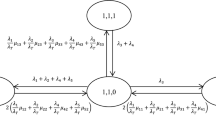Abstract
The staging (or locating) of air ambulances throughout a jurisdiction of responsibility is widely accepted to be influential in achieving positive patient outcomes. Traditionally, the assignment of bases is made as a function of either population density or by maximizing coverage. This work leverages historical data detailing missions executed by an air ambulance service to identify locations for bases that minimize the total distances flown by the fleet throughout the study period. Given the known computational complexity of the problem (NP-hard), and volume of data being examined, a genetic algorithm was chosen due to its demonstrated effectiveness at solving combinatorial problems. Over the course of the evolutionary process, the objection function value of the population’s best-performing chromosome decreased by 24%.
Access this chapter
Tax calculation will be finalised at checkout
Purchases are for personal use only
Similar content being viewed by others
References
Archetti, C., Feillet, D., Speranza, M.G.: Complexity of routing problems with release dates. Eur. J. Oper. Res. 247(3), 797–803 (2015)
Blackwell, T.H., Kline, J.A., Willis, J.J., Hicks, G.M.: Lack of association between prehospital response times and patient outcomes. Prehospital Emerg. Care 13(4), 444–450 (2009)
Cannon, E., Shaw, J., Fothergill, R., Lindridge, J.: Ambulance response times and mortality in elderly fallers. Emerg. Med. J. 33(9) (2016)
Dong, Z., Chuhang, Y., Lau, H.Y.K.H.: An integrated flight scheduling and fleet assignment method based on a discrete choice model. Comput. Ind. Eng. 98, 195–210 (2016)
Fernández-Cuesta, E., Norddal, I.K., Andersson, H., Fagerholt, K.: Base location and helicopter fleet composition in the oil industry. INFOR: Inf. Syst. Oper. Res. 55(2), 71–92 (2017)
Garey, M.R., Johnson, D.S.: Computers and Intractability: A Guide to the Theory of NP-Completeness. W.H Freeman and Company, New York (1977)
Gopalan, R.: Computational complexity of convoy movement planning problems. Math. Methods Oper. Res. 82(1), 31–60 (2015)
Huwang, M., Chiang, C., Liu, Y.: Solving a fuzzy set-covering problem. Math. Comput. Model. 40(7–8), 861–865 (2004)
Jeong, H., Moon, H., Lee, J., Lee, D., Choi, J., Jung, Y.: The effect of ambulance response time in the outcomes of patients with out-of-hospital cardiac arrest. Resuscitation 118, e35 (2017)
Koç, Ç., Bektaş, T., Jabali, O., Laporte, G.: The fleet size and mix location-routing problem with time windows: formulations and a heuristic algorithm. Eur. J. Oper. Res. 248(1), 33–51 (2016)
Maleki, M., Majlesinasab, N., Sepehri, M.M.: Two new models for redeployment of ambulances. Comput. Ind. Eng. 78, 271–284 (2014)
McCormack, R., Coates, G.: A simulation model to enable the optimization of ambulance fleet allocation and base station location for increased patient survival. Eur. J. Oper. Res. 247(1), 294–309 (2015)
Perez, M.: Response time to the emergency department (ED) and its effect on patient flow and hospital outcomes. Chest 148(4) (2015)
Schmid, V.: Solving the dynamic ambulance relocation and dispatching problem using approximate dynamic programming. Eur. J. Oper. Res. 219(3), 611–621 (2012)
Zhen, L., Wang, K., Hu, H., Chang, D.: A simulation optimization framework for ambulance deployment and relocation problems. Comput. Ind. Eng. 72, 12–23 (2014)
Zimmermann, K.: Fuzzy set covering problem. Int. J. Gen. Syst. 20(1), 127–131 (1991)
Author information
Authors and Affiliations
Corresponding author
Editor information
Editors and Affiliations
Rights and permissions
Copyright information
© 2018 Springer Nature Switzerland AG
About this paper
Cite this paper
Pond, G.T., McQuat, G. (2018). Optimizing Fleet Staging of Air Ambulances in the Province of Ontario. In: Fagan, D., Martín-Vide, C., O'Neill, M., Vega-Rodríguez, M.A. (eds) Theory and Practice of Natural Computing. TPNC 2018. Lecture Notes in Computer Science(), vol 11324. Springer, Cham. https://doi.org/10.1007/978-3-030-04070-3_17
Download citation
DOI: https://doi.org/10.1007/978-3-030-04070-3_17
Published:
Publisher Name: Springer, Cham
Print ISBN: 978-3-030-04069-7
Online ISBN: 978-3-030-04070-3
eBook Packages: Computer ScienceComputer Science (R0)




